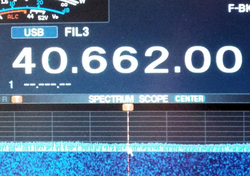8-Meter Experimental Station on the Air from the US
WL2XUP is an FCC Part 5 Experimental station operated by Lin Holcomb, NI4Y, in Georgia. It’s licensed to operate with up to 400 W effective radiated power (ERP) between 40.660 MHz to 40.700 MHz.

John Desmond, EI7GL, reports that as of mid-July, WL2XUP was intermittently transmitting on Weak-Signal Propagation Reporter (WSPR) on 40.662 MHz (1500 Hz) for 2 minutes out of every 10, with an output power of 20 W ERP into an omnidirectional antenna. For FT8 check-ins and tests, an ERP of 100 W may be used. The band is affected by several propagation modes, including tropospheric ducting, sporadic E, transequatorial propagation (TEP), and F2 propagation. As Desmond notes, the 40 MHz band will open a lot earlier than 50 MHz and could be a useful resource for stations monitoring the transatlantic path.
A 2019 Petition for Rulemaking (RM-11843) asked the FCC to create a new 8-meter amateur radio allocation on a secondary basis. The Petition suggests the new band could be centered on an industrial-scientific-medical (ISM) segment somewhere between 40.51 and 40.70 MHz. The spectrum between 40 and 41 MHz is currently allocated to the federal government and, as such, within the purview of the National Telecommunications and Information Administration (NTIA).
ARRL member Michelle Bradley, KU3N, of Maryland, filed the petition on behalf of REC Networks, which she founded and described in the Petition as “a leading advocate for a citizen’s access to spectrum,” including amateur radio spectrum.
Back





